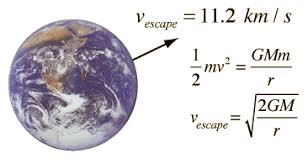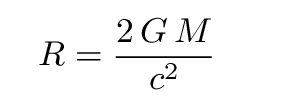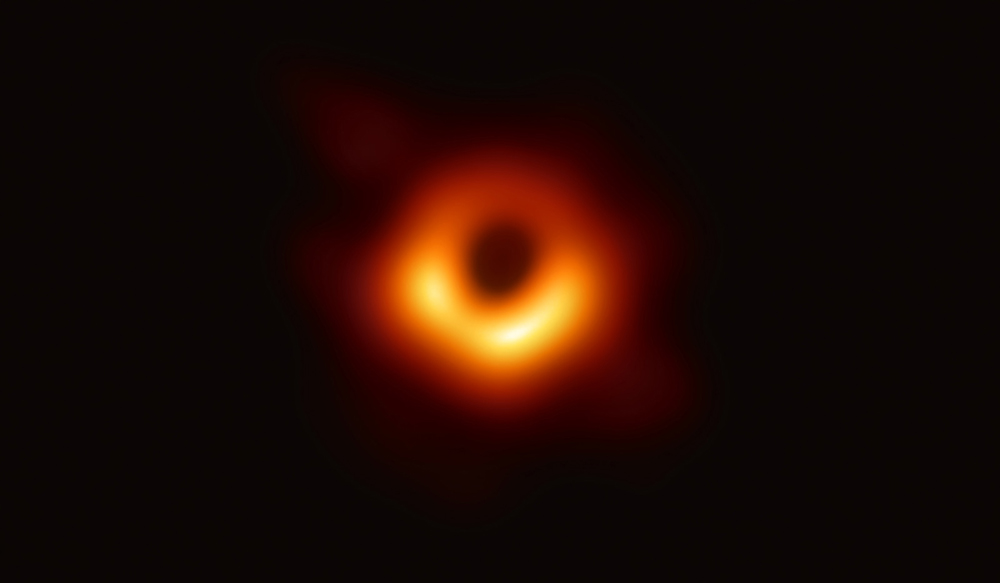White holes and Black holes:
White holes were a new idea that i had not heard about until you, the students, brought it up. In doing some reading i find my self fascinated by this example of the scientific process. To start with it seems like we would do well to describe what a black hole is and why we believe they exist. Then we can move on to white holes.....
Escape Velocity:
The faster something is thrown up in the air the farther away it goes before it falls back to earth -- no surprises there. Probably many of us experimented with this idea when we were kids trying to see how far we could get a ball to go. One can certainly imagine getting an object going fast enough that it would leave the earth forever or at least make it into orbit. For an object, like a ball, that has no internal means of propulsion we can actually calculate what that speed is from our understanding of gravity.

Given that light is the fastest thing we know of we can calculate the radius of an object for whom the escape velocity is the speed of light. You may be aware that we usually indicate the speed of light with the symbol c where c = 3 108 m/s which is very fast. G is Newton's gravitational constant and is 6.67 10-11 m3/kg-s. The fact that this is a small number is why we say that gravity is a relatively weak force. All together what this means is that if an object of particular mass gets smaller than some radius even light will not be able to escape. That radius is given by this expression (algebra from the one above).

This is known as the Schwarzschild radius and is the same as the radius of the event horizon which you may have heard about..
This is all well and good. It suggests that there could be such a thing as an object from which light can not escape (that would make it black!) but how would it form and how could we detect it? The formation of black holes is ultimately a questions of how to get enough stuff or energy inside a small enough boundary. The collapse of really large stars has been thought to be one of the ways this might happen. It is perhaps more useful to ask how we would detect such a thing as a black hole if it existed.
Black Holes:
We've been thinking about black holes for a long time and have various models for what we expect to happen around and near black holes. Those models suggest certain types of radiation are expected to be released as material falls into the black hole. This is what we call the signature of a black hole.
Another way we might detect a black hole is through the orbits of large objects that appear to be influenced by small dense invisible objects. This is another tool for detecting really large black holes.
Eventually, as we developed new instruments and better telescopes, we started to see objects in the universe that showed the predicted signatures of a black hole. This is why we say that we believe that there is a super massive black hole at the center of our galaxy.
Given that the closest large black hole to us would be at the center of our galaxy there is the question of how to capture an image (take a picture) of such a small object so far away. Here is a lovely presentation from one of the team that created the software tools to support the effort.
This TEDx presentation was made before the image was actually captured. Here is the actual image that was 'captured'.

Here is a presentation from Veritasium that may help you understand what the image is telling us.
Since he references his presentation on spinning black holes I include it here.
Gravity Waves and Black Holes:
It has long seemed like gravity should be capable of producing ripples in the universe the same way that rocks tossed in a pond create ripples. The challenge is that gravity is a relatively weak force and the ripples it makes are tiny except in some extreme cases. One extreme case that has been imagined is the merging of two black holes. Given the enormous mass of black holes the merging of black holes would be one of the most dramatic and abrupt changes in gravity that we can imagine. Colliding galaxies is definitely more dramatic but it happens over such a long period of time that the ripples are insignificant. LIGO is an experiment which has sites in Washington State (Hanford) and Louisiana (Livingston) specifically designed to watch for an event like two black holes merging. Much to everyones amazement LIGO 'saw' such and event almost as soon as they turned the experiment (in 2017) on (after starting construction in 1990. That first event has been frequency shifted so we can hear it and this is the LIGO 'chirp' that is the result of the two black holes merging.
Remarkably this signal was an exact match for the expected signal and is likely to get the Nobel Prize in Physics some day. This really does suggest that our ideas and expectations about black holes may be largely correct. On the other hand I think it is valuable to consider this commentary about this remarkable event from one of the LIGO researchers.
...and finally there's the question of 'evaporation' of black holes. I don't know anything about this and I can barely understand this article but here it is in case you're interested.
Ethan Siegel again -- Evaporation of Black Holes: A consequence of the ideas in this article is that smaller black holes actually evaporate faster than big one. That's why we weren't supposed to worry if CERN created some microscopic black holes as they were looking for the Higgs Boson. A lot of trust involved there......
White Holes:
Here is a NOVA article about white holes. We will go look at it after a brief discussion about mathematically possible objects and science. One of the features of complicated theories and models that are developed to seek to explain the world around us is that they often contain the possibility of things we haven't seen yet. Science folks who work in this realm often indulge their curiousity by exploring what the model indicates is possible in extreme situations. Sometimes we are able to find objects predicted by these explorations which tends to confirm the model and sometimes we can't find the objects which tends to make us wonder if we need to seek a different or better model. This is the fundamental story of white holes. They do seem to be allowed in some of our models of the universe but we're not sure how to look for them. Unlike black holes where we have some ideas of what they would 'look like' we have no clear idea of what the signature of a white hole is. There is lots of wonderful speculation but no real evidence at this point. We will look through the article linked above for some general sense of white holes.
HW: Black Holes
How big or small (heavy or light) can a black hole be? Does the basic theory suggest they can only be one size or are there multiple possibilities?
HW: Black Holes
Did we actually take a picture of a black hole? How is the process by which we took this 'picture' different than what we usually think of as picture taking.
